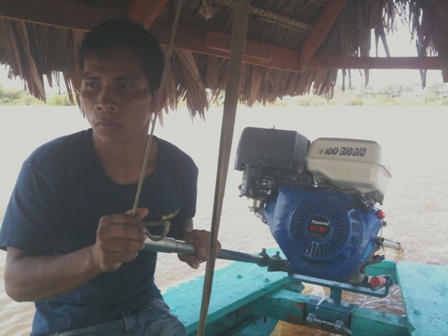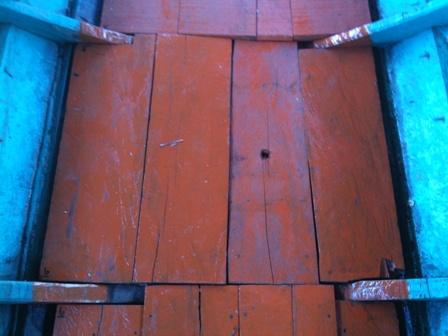Peque-Peque motors look like weedeaters on steroids—big motor, long shaft, little prop on the end. Those outboard motors may look strange but they’re perfect for moving around creeks and swamps here in eastern Peru. I’ve pushed through muck only inches deep with a peque-peque on a canoe—the prop only half in the water and still getting enough push to get through.

But on the open water like the Amazon River, peque-peques are another story. By the way they’re built, the mysteries of prop thrust wants to raise the prop out of the water. Motoristas (guys who run boats) overcome this prop rise by lifting on the tiller on the front of the motor. That keeps the prop in the water but on the long hauls the constant lifting and vibration, wears out the strongest motorista. To get around this, motoristas tie a cord to the tiller and the other end to the roof of the boat keeping the tiller up and the prop in the water. That is until you hit a log. Then the shaft goes up over the log the tiller on the other end pulls down, snaps the cord and the motorista sizes up the situation, saves the day, and reties the cord to the roof. All this more or less works until you size the cord wrong. That happened to me the other day.
Luis Beltran, Gemma Mozombite, and I were making our way back to Iquitos, Peru on the Amazon River. After a couple of hours hefting the tiller Luis felt it was time to tie it to the boat roof. I looked around for some string or cord and not finding any decided on a piece of woven pretina strap—the kind of stuff they lift cargo into ships with. Luis looked at me with suspicion, but we tied the pretina strap to the tiller and to the ridge pole on the roof then sat back for a pleasant morning cruise up the river. I was up front on the prowl, Luis back at the motor. It was a great morning everything was going fine until I saw something long and dark the water. Of course it was the inevitable log crossways of the boat and heading for us. I started yelling “palo palo,” Gemma waved her arms, while Luis was trying to untie the strap from the tiller. I felt the log dance along the entire eleven meter bottom of the boat. But it was too late. The log cleared the stern of the boat then an instant later nailed the prop shaft. The shaft lifted over the log, the tiller in front wanted to come down, but the thick strap wouldn’t snap so all hell broke loose. The motor tore out of its mount. The motor mount itself tore free from the boat and went to the fishes. The motor, now free was lying on its side running wide open and like some Jurassic throwback desperately trying to return to the river and only kept so by the pretina strap which caused all the problems in the first place.
Well, Luis and I managed to find the ignition switch, shut off the motor and drag the thing out of the water and back into the boat. The motor seemed ok. At least it was running. But the motor mount was gone. After collecting ourselves, we tore out a couple of planks from the floor and along with a piece of 2×2 made something resembling a motor mount. With a screwdriver we chopped a hole through the boards to take the motor swivel pin and tied the whole thing to the boat with the evil pretina cord.

It seemed to work. In fact it seemed to work better than the original metal mount. The heavy planks along with the woven strap seemed to dampen out the vibrations that had always plagued that motor. Back in Iquitos, we tore apart the rig, put the planks back in the floor. Now as I walk over the boat floor and see the holes from the jury rig, it reminds me to always size the tiller cord right.

